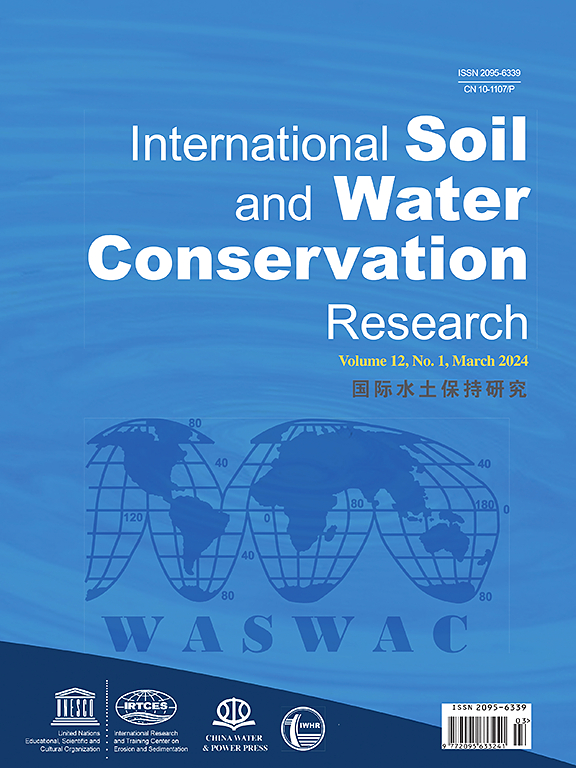VIS-NIR spectroscopy and environmental factors coupled with PLSR models to predict soil organic carbon and nitrogen
IF 7.3
1区 农林科学
Q1 ENVIRONMENTAL SCIENCES
International Soil and Water Conservation Research
Pub Date : 2024-02-14
DOI:10.1016/j.iswcr.2024.02.001
引用次数: 0
Abstract
Soil profile organic carbon (OC) and total nitrogen (TN) are influenced by topographic attributes, and land use. The visible and near-infrared (Vis-NIR) spectroscopy method can be used for the prediction of OC and TN because it is reliable, nondestructive, fast, and cost-effective. VIS-NIR soil spectral and environmental data were combined with the Partial least squares regression (PLSR) model to examine the effect of topography attributes and land use on topsoil and subsoil OC and TN stocks. After this, based on the soil depth, 114 soil samples were collected from 0 to 20 cm (topsoil) and 20–50 cm (subsoil) under three land uses, as well as OC and TN, along with several soil properties including soil particles (sand, silt, clay), pH, and bulk density in both topsoil and subsoil samples were measured. A DEM with a resolution of 30 m was used to derive the topography factors and remote sensing data was used to calculate the vegetation index. Soils (0–50 cm) under orchard land use had the highest stock of SOC (7.4 kg m−2) as well as TN (2.4 kg m−2). There was a significant increase in the organic matter stock of soils located on the south aspect (8.3 kg m−2) compared to soils located on other aspects, particularly on the north aspect (3.9% increase). Soils on the south aspect contain higher soil-water contents and lower temperatures, resulting in a decrease in the decomposition of soil organic matter. A strong positive correlation was demonstrated between topography wetness index (0.57–0.63) and topography TN stocks (0.54–0.66) as well as the highest loading score among terrain attributes, suggesting that topography is the primary factor controlling SOC stocks, particularly subsoil stocks. Additionally, we found that soils on the south-facing aspects (N aspects) had the highest spectra. Additionally, the PLSR, which showed an R2 of 0.82, a RMSE of 0.15 %, and a RPD of 0.39 indicated excellent prediction capabilities for the OC content. We concluded that the PLSR model coupled with Vis-NIR spectroscopy is able to predict topsoil and subsoil OC and N content under different aspect slopes.
利用 VIS-NIR 光谱和环境因素以及 PLSR 模型预测土壤有机碳和氮
土壤剖面有机碳(OC)和总氮(TN)受地形属性和土地利用的影响。可见光和近红外(Vis-NIR)光谱法具有可靠、无损、快速和成本效益高的特点,可用于预测有机碳和全氮。将 VIS-NIR 土壤光谱和环境数据与偏最小二乘回归(PLSR)模型相结合,研究了地形属性和土地利用对表土和底土 OC 和 TN 储量的影响。随后,根据土壤深度,采集了三种土地用途下 0 至 20 厘米(表土)和 20 至 50 厘米(底土)的 114 个土壤样本,并测量了表土和底土样本中的 OC 和 TN 以及土壤颗粒(沙、粉土、粘土)、pH 值和容重等多种土壤特性。使用分辨率为 30 米的 DEM 得出地形系数,并使用遥感数据计算植被指数。果园用地土壤(0-50 厘米)中的 SOC(7.4 千克/平方米)和 TN(2.4 千克/平方米)含量最高。南面土壤的有机质储量(8.3 千克/平方米-2)比其他面的土壤明显增加,尤其是北面(增加 3.9%)。南面的土壤含水量较高,温度较低,导致土壤有机物分解减少。地形湿润指数(0.57-0.63)与地形 TN 储量(0.54-0.66)之间存在很强的正相关性,并且在地形属性中负荷分值最高,这表明地形是控制 SOC 储量(尤其是底土储量)的主要因素。此外,我们还发现朝南的土壤(北向)具有最高的光谱。此外,PLSR 的 R2 为 0.82,RMSE 为 0.15 %,RPD 为 0.39,表明其对 OC 含量具有出色的预测能力。我们的结论是,结合可见光-近红外光谱的 PLSR 模型能够预测不同坡度下表土和底土的 OC 和 N 含量。
本文章由计算机程序翻译,如有差异,请以英文原文为准。
求助全文
约1分钟内获得全文
求助全文
来源期刊

International Soil and Water Conservation Research
Agricultural and Biological Sciences-Agronomy and Crop Science
CiteScore
12.00
自引率
3.10%
发文量
171
审稿时长
49 days
期刊介绍:
The International Soil and Water Conservation Research (ISWCR), the official journal of World Association of Soil and Water Conservation (WASWAC) http://www.waswac.org, is a multidisciplinary journal of soil and water conservation research, practice, policy, and perspectives. It aims to disseminate new knowledge and promote the practice of soil and water conservation.
The scope of International Soil and Water Conservation Research includes research, strategies, and technologies for prediction, prevention, and protection of soil and water resources. It deals with identification, characterization, and modeling; dynamic monitoring and evaluation; assessment and management of conservation practice and creation and implementation of quality standards.
Examples of appropriate topical areas include (but are not limited to):
• Conservation models, tools, and technologies
• Conservation agricultural
• Soil health resources, indicators, assessment, and management
• Land degradation
• Sustainable development
• Soil erosion and its control
• Soil erosion processes
• Water resources assessment and management
• Watershed management
• Soil erosion models
• Literature review on topics related soil and water conservation research
 求助内容:
求助内容: 应助结果提醒方式:
应助结果提醒方式:


